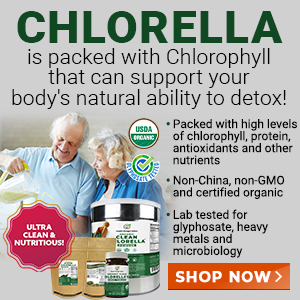
DIM Lowers Potential of Cancer Cell Metastasis, Invasion and Angiogenesis
Thursday, June 05, 2008 by: Barbara L. Minton
Tags: anti-cancer foods, health news, Natural News
- Newly released JFK files reveal Pentagon's role in creating Lyme disease and covid in the same lab
- Kiss Your Genetic Privacy Good-Bye! 23andMe Gets Green Light to Sell Your Intimate Genetic Details to Anyone They Want
- Woman contracts WORLD'S DEADLIEST VIRUS after unknowingly being given the WRONG VACCINE
- Sweden's migrant crisis deepens as failed green energy venture leaves thousands jobless, exposes systemic collapse
- AI weather model outperforms traditional forecasts, boosts accuracy by 20%
- Advisory: Ex-FBI agent exposes likely ATF honeypot operation selling illegal Glock switches
- The case for locking up the Deep State's biggest hatchet man...
- Revolutionize your diet with pomegranate: The miracle juice for gut health and metabolism
- Pediatric dentist exposes fluoride dangers as more states ban toxic water additive
- Could camel milk be a game-changer for autism? Science says it’s worth exploring
- North Carolina Supreme Court rules family can sue over COVID-19 force-vaccination of teen without parental consent
- Analysis: The coming economic collapse, a mass uprising and Trump's three secret weapons to halt the growing revolt
- DHS Secretary Kristi Noem plans to dismantle FEMA
- Can special diets and supplements help kids with autism? A new research offers hope and hints at what works
- Ann Vandersteel on the Health Ranger Report: Operation Burning Edge, the dollar empire’s collapse and the rebirth of America’s sovereignty
- Alex Epstein defends energy progress in his book “The Moral Case for Fossil Fuels”
- NIH to crack down on taxpayer-funded censorship: A victory for academic freedom
- Trump’s USDA policies drive egg prices down nearly 60%
- Newly released JFK files reveal Pentagon's role in creating Lyme disease and covid in the same lab
- Analysis: The coming economic collapse, a mass uprising and Trump's three secret weapons to halt the growing revolt
- Trump nominates VACCINE ZEALOT Susan Monarez to lead the CDC, sidelining RFK Jr.'s reform efforts
- Trump's greatest betrayal so far: Accelerating Middle East wars, silencing dissent, and serving Zionist masters
- CDC finally halts $11 billion COVID funding scam as health officials admit the ‘pandemic’ was a fraud
- The hidden dangers in your kitchen: How cooking methods impact diabetes, cancer and aging
- BEWARE: USDA allows genetically engineered vaccines to infiltrate organic food production
- Obama accused of laundering USAID funds to fuel global protest movements, regime change operations
- DEADLY DECEPTION: How COVID vaccines increased mortality rates and why authorities hid the truth
- Here are TEN all-natural ways to protect your garden without using harmful chemicals
- Dr. Mike Yeadon releases 15-minute testimony - WATCH - about genocidal intent of COVID “vaccines”
- Festive flavors: The sweet history, nutritional profile and health benefits of pecan pie
- Big Pharma's media takeover: How drug companies bought the news - and your health
- Dr. Suzanne Humphries makes bombshell appearance on Joe Rogan podcast, exposing vaccine industry deception back to POLIOMYELITIS
- Elon Musk: Aliens could be here on Earth RIGHT NOW
- 5 Simple steps to boost your brainpower: How to strengthen executive function in a distracted world
- Trump reverses course on Gaza plan, says “nobody is expelling Palestinians”
- California's social media censorship law struck down: A victory for free speech or a threat to online safety?
- Newly released JFK files reveal Pentagon's role in creating Lyme disease and covid in the same lab
- EPA advisor admits the agency is funneling billions to climate groups ahead of Trump’s return to White House
- California's social media censorship law struck down: A victory for free speech or a threat to online safety?
- Dr. Mike Yeadon releases 15-minute testimony - WATCH - about genocidal intent of COVID “vaccines”
- The Health Ranger releases “Vaccine Zombie” song and music video, using AI-animated zombies for the music video
- Florida takes a stand: DeSantis proposes permanent ban on mRNA vaccine mandates
- The pandemic as a tool for INDOCTRINATION: Understanding “The Indoctrinated Brain” by Dr. Michael Nehls
- “Why we influenced the 2020 elections”: Facebook files reveal the coordinated effort to bury the Hunter Biden laptop story
- Mike Adams releases country western hit single: Goin’ Back in Time is Comin’ Home
- Mike Adams releases music poetry sensation: A Child of God
- Unpacking the Lies That We’ve Been Fed – new song and music video released by Mike Adams, the Health Ranger
- Michigan sheriff announces criminal investigation into 2020 election crimes, Dominion Voting Systems
- Migrants are taking advantage of recent hurricanes to scam residents and loot their homes
- House Intelligence Committee calls for the ARREST and PROSECUTION of Dr. Anthony Fauci
- Rep. Nancy Mace introduces bill to ban biological males from female facilities on federal property
- Peter Rost exposes Big Pharma corruption in his book “The Whistleblower: Confessions of a Healthcare Hitman”
- Former horse rancher and 6,000 other plaintiffs are suing Syngenta after paraquat exposure led to Parkinson's Disease
- Mike Adams releases new song and music video: Nothing More Disgusting Than a Globalist
- Red Cross issues warning to stop blood plasma donations from vaccinated people
- Scientists confirm: GENIUS brain function can be spontaneously unleashed in humans without any apparent cause
- EPA advisor admits the agency is funneling billions to climate groups ahead of Trump’s return to White House
- HYSSOP: What research reveals about the health benefits of this ancient holy herb
- Two containers with completed ballots fall out of truck in Florida
- Fully vaccinated about to see “tsunami” of illness and death, warns virologist
- Global leaders unite to clamp down on “misinformation” with UN-backed Cascais Declaration
- BREAKING: 2025 NDAA authorizes mandatory military draft of WOMEN across America… as Pentagon pursues global NUCLEAR war with both Russia and China at the same time
- Michael Yon warns of a ZIONIST TAKEOVER in Trump’s second administration
- BOMBSHELL: DNA testing kits are a SCAM to develop ethnic-specific bioweapons
- Ozempic and Wegovy weight loss drugs are injectable LIZARD VENOM PEPTIDES that may unleash a devastating wave of organ failure… side effects align with symptoms of SNAKE BITES
- Israeli soldiers accused of even more torture and abuse in the West Bank
- These 13 countries just signed an agreement to engineer a global FAMINE by destroying food supply
- NASA admits that climate change occurs because of changes in Earth’s solar orbit, and NOT because of SUVs and fossil fuels
- RFK Jr. clears key hurdle: Sen. Susan Collins backs controversial HHS nominee, signaling a new era for health policy
- Sermon 30: How Jesus reveals Caesar’s FAKE CURRENCY and FALSE AUTHORITY
- Coriander seeds: Ancient medicine backed by modern science
- Arizona officials claim Maricopa County needs 10-13 days to tabulate results of the election
Recent studies and results
In a study published in the May 1, 2008 Biochemical Pharmacology Journal, researchers report having previously shown that DIM is able to stop tumors from establishing their own blood supply (angiogenesis) in cultured endothelial cells in rodents. In this study, they demonstrated that DIM reduces the level of hypoxia-inducible factor (HIF)-1alpha in hypoxic tumor cell lines, as well as HIF-1 transcriptional activity. Moreover, the level of oxygen in tumor cells was increased. This study is the first to show that DIM can decrease the accumulation and activity of the key angiogenesis regulatory factor, HIF-1alpha, in hypoxic tumor cells.
The April 22, 2008 Pharmaceutical Research reports that prostrate apoptosis response-4 (Par-4) is a unique pro-apoptotic protein that selectively induces apoptosis in prostate cancer cells. Apoptosis is the planned appropriate death of cells without which cells may exhibit excess proliferation. Researchers sought to identify the functional significance of Par-4 in pancreatic cancer. Results revealed that low doses of the B-DIM (the most bioavailable formulation of DIM) induced Par-4 in pancreatic cancer cells. DIM reduced cancer cell viability and caused cell growth inhibition and apoptosis.
The Cancer Letter, March 28, 2008 reports that the interaction between the chemokine receptor and its unique ligand is known to mediate the progression and metastasis of breast and other cancers. Organs to which these cancers metastasize secrete the particular ligand which binds to the chemokine receptor on the surface of primary cancer cells. This process subsequently stimulates the invasive properties of the cancer cells and attracts them to the preferred organ sites of metastases. The researchers found that DIM down-regulates both the ligand and the receptor in breast cancer cells as well as in ovarian cancer cells at the transcriptional level and in an estrogen-independent manner. They demonstrated that the potential of cells for chemotaxis and invasion is inhibited by DIM. Furthermore, they showed that DIM down-regulates the chemokine receptor under hypoxia and the ligand under estradiol-inducing conditions. The data suggest that one mechanism whereby DIM protects against breast, ovarian, and possibly other cancers is through the repression of this mechanism, thereby lowering the invasive and metastatic potential of these cells.
From the March 15, 2008 Cancer Research comes a study reporting that platelet-derived growth factor-D (PDGF-D) is a newly recognized growth factor known to regulate many cellular processes, including cell proliferation, transformation, invasion, and angiogenesis. Recent studies have shown that PDGF-D and its receptor are expressed in prostate tumor tissues, suggesting that PDGF-D plays an important role in the development and progression of prostate cancer. Researchers found that PDGF-D was significantly inhibited by B-DIM. This correlated with decreased cell proliferation and invasion. B-DIM also inhibited the tube formation of human umbilical vein endothelial cells. They concluded that B-DIM could serve as an efficient preventative and/or therapeutic agent in prostate cancer.
Molecular Cancer Therapeutics February, 2008, reports a study of human breast cancer cell lines to understand the mechanisms of DIM. In vitro experiments were done with breast cancer cell lines. Researchers found that DIM inhibited the growth of all four breast cancer cell lines. Because two of the cell lines over expressed Her-2 and two of the lines lacked estrogen receptors, these were studied further. In both cell lines, DIM appeared to induce expression of p27 protein before the loss of cell viability and apoptosis. DIM induced p27 transcript expression within 6 hours. DIM also induced nuclear localization of p27 in both cell lines. In one of the cell lines, DIM induced a decrease in phosphorylation. Researchers concluded that DIM modulates p27 through transcription, prolongation of protein half-life, and nuclear localization. These effects appear to be independent of Her-2, or estrogen receptor status.
The January, 2008 Journal of Nutrition finds that because recurrent or chronic inflammation has been implicated in the development of a variety of human cancers, researchers examined the anti-inflammatory effects of DIM and the underlying mechanisms using lipopolysaccharides (LPS) stimulated macrophages. DIM significantly decreased the release of nitric oxide, prostaglandin E2, tumor necrosis factor alpha, interleukin-6 and IL-1beta cells treated with LPS. DIM inhibited LPS induced increases in protein levels of inducible NO synthase. The messenger RNA levels of phospholipase A2 decreased, whereas neither COX 2 protein nor transcript was altered. Researchers concluded that DIM inhibits LPS induced release of pro-inflammatory mediators in macrophages.
DIM is nature's hormone modulator
Though discovered about 20 years ago, most research on DIM until recently involved its ability to modulate hormones. Researchers discovered that the metabolism and growth promoting activity of estrogen is modified by the intake of milligram amounts of dietary indoles from cruciferous vegetables. DIM is formed from its precursor indole, Indole-3-carbinol (I3C), after the enzymatic release of 13C from parent glucosinolates found in all cruciferous vegetables. DIM is unique among all phytonutritionals with regard to its ability to favorably modify estrogen metabolism in the direction of greater 2-hydroxy estrogen production. Improper metabolism of estrogen allows for oxidation, damage to DNA and cancer promotion to take place.
Epidemiology shows a high prevalence of estrogen related disease, especially breast cancer, in societies consuming a diet low in total vegetable content. And this is why, if you are diagnosed with breast cancer, you are told that your hormones are your enemy. Since the disease establishment continues to perpetuate the charade that diet has no impact on health, they won't tell you the truth. This truth is that a diet deficient in vegetables is your enemy, not your own natural estrogen.
This is also why the disease establishment treats breast cancer with drugs designed to place you in a perpetual state of hormone deficiency. And his is why, if you accept traditional treatments called the standard of care, you are left feeling like a shadow of your formal self with no interest in sex. That's before you decline into Alzheimer's Disease, heart attack or cancer reoccurrence.
Supplementing with DIM can restore and maintain a favorable estrogen metabolism and greatly lessen your risk for breast and other cancers. If your have already had any of these cancers, DIM supplementation can drastically cut your chances of a reoccurrence. If you choose to continue living your life to the fullest, even after having had breast or other cancers, you may have chosen to use bio-identical hormones. DIM can increase the safety of this decision by making sure estrogen is properly metabolized.
Men stay healthier and get their mojo back
DIM is not just for women. Aging related alteration in estrogen metabolism is an under appreciated factor in men's health. Estrogen is a growth promoting hormone in men as well as in women. DIM promotes the same beneficial estrogen metabolism in men that it does in women. Improper metabolism of estrogen is a high risk factor for prostate cancer. Elevated estrogen in men further correlates to a decreased ability to dissolve blood clots.
DIM can often restore sexual functioning in aging men. Most men produce an adequate amount of testosterone for most of their lives. The problem for men is the conversion of testosterone into estrogen that is improperly metabolized. This is what's happening when erectile dysfunction sets in. DIM prevents or greatly reduces this conversion. A man supplementing with DIM may find his pot belly receding, and his morning erections returning.
DIM and decreased cancer risk
Supplemental use of DIM increases the production of 2-hydroxy estrogen by 75% and decreases by 50% the production of 16-hydroxy estrone, considered the "bad" form of estrogen. An increased proportion of 2-hydroxy metabolites is correlated to protection from breast cancer, as documented in several case-control studies. These case-control studies have also documented that low levels of 2-hydroxy metabolites are associated with breast cancer in men, familial risk of cancer, uterine cancer, cervical cancer, and systemic lupus erythematosus. Other established risk factors for breast cancer have also been correlated with low 2-hydroxy estrogen production such as obesity, high fat diets, and diets deficient in Omega-3 fatty acids.
DIM is not an estrogen mimic or phytoestrogen, and it has no inherent estrogenic activity. DIM balances the natural response to estrogen by adjusting the activity of metabolic cytochrome enzymes and specialized estrogen receptor molecules. In dividing cells, the growth promoting signal from estrogen is limited by the reduction of the activity level of the estrogen receptor system. DIM also promotes the pathways of metabolism of estrogen within cells to favor the cancer preventive metabolites, 2-hydroxy and 2-methoxy estrogen. These metabolites further limit cell division and growth through influence on the cell cycle which determines growth and replication.
Supplementing with DIM
Supplements of I3C are available and have been documented as safe. However, since I3C is highly unstable, its long term use as a dietary supplement is of questionable value. I3C has been shown to be a precursor dietary indole, without activity in the body until it is converted to DIM by stomach acid. This process is inefficient and may be ineffective in those with lower levels of gastric acid production.
DIM is an appropriate supplement for pre and postmenopausal women. Although obtaining nutrients from food is always preferred, the amount of cruciferous vegetables needed to provide the benefits of DIM frequently make supplementation a better choice in this case. Many people find that digestion of cruciferous vegetables is difficult and may produce unpleasant side effects.
Some of the reported studies used B-DIM, the patented BioResponse DIM complex providing enhanced bioavailability. This is the preferred form for DIM supplements because the extreme water insolubility of DIM in its crystalline form requires an absorption enhancing delivery system.
There are several companies that make the BioResponse DIM complex. Many are available at the major online supplement stores. Natures Way DIM-plus is a good, economical choice. There are others that will also work well.
Additional sources:
Michael A. Zeligs, M.D., "All About Diindolylmethane" (http://www.dimfaq.com/index.htm)
About the author
Barbara is a school psychologist, a published author in the area of personal finance, a breast cancer survivor using "alternative" treatments, a born existentialist, and a student of nature and all things natural.Anti-cancer foods at FETCH.news
Get independent news alerts on natural cures, food lab tests, cannabis medicine, science, robotics, drones, privacy and more.
Take Action: Support Natural News by linking to this article from your website
Permalink to this article:
Embed article link: (copy HTML code below):
Reprinting this article:
Non-commercial use OK, cite NaturalNews.com with clickable link.
Follow Natural News on Facebook, Twitter, Google Plus, and Pinterest
Science News & Studies
Medicine News and Information
Food News & Studies
Health News & Studies
Herbs News & Information
Pollution News & Studies
Cancer News & Studies
Climate News & Studies
Survival News & Information
Gear News & Information
News covering technology, stocks, hackers, and more



"Big Tech and mainstream media are constantly trying to silence the independent voices that dare to bring you the truth about toxic food ingredients, dangerous medications and the failed, fraudulent science of the profit-driven medical establishment.
Email is one of the best ways to make sure you stay informed, without the censorship of the tech giants (Google, Apple, Facebook, Twitter, YouTube, etc.). Stay informed and you'll even likely learn information that may help save your own life."
–The Health Ranger, Mike Adams












































